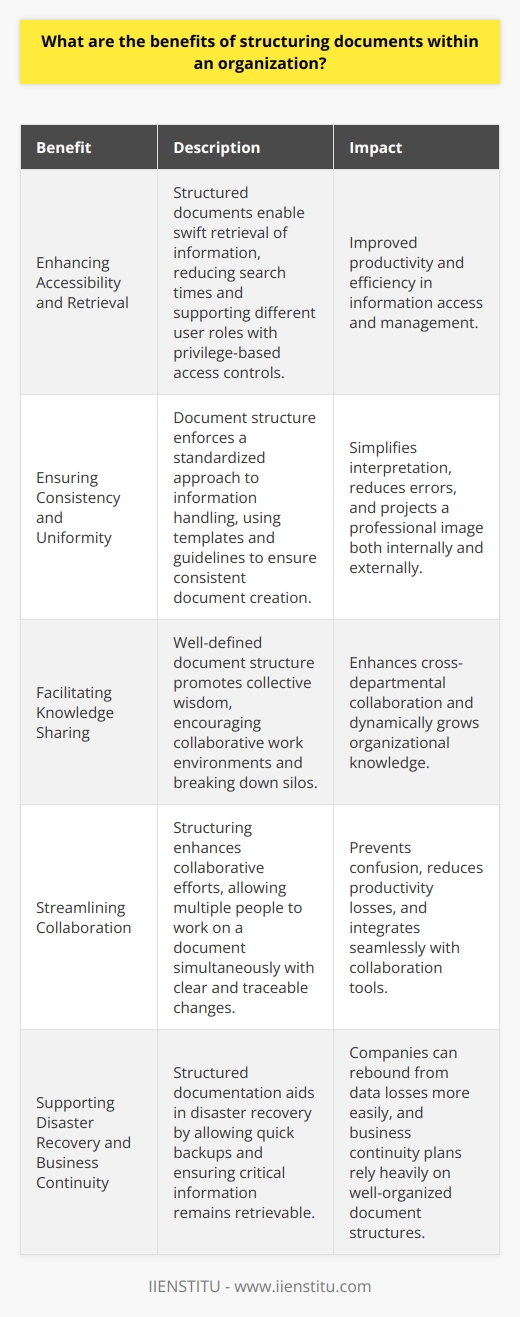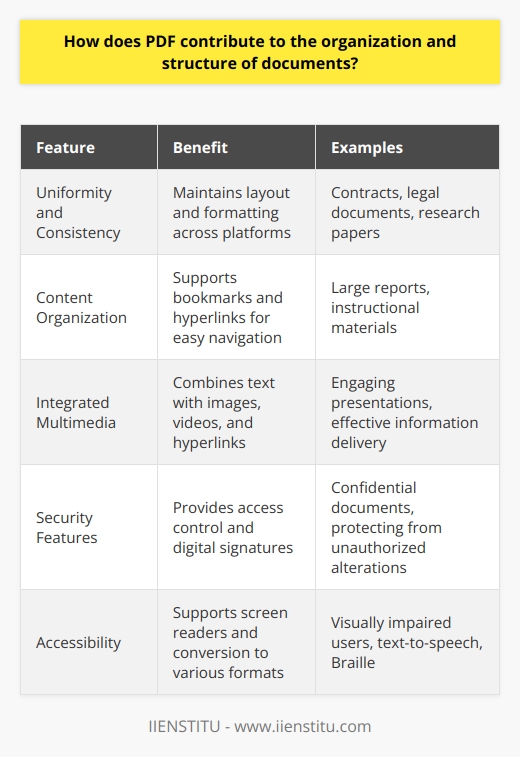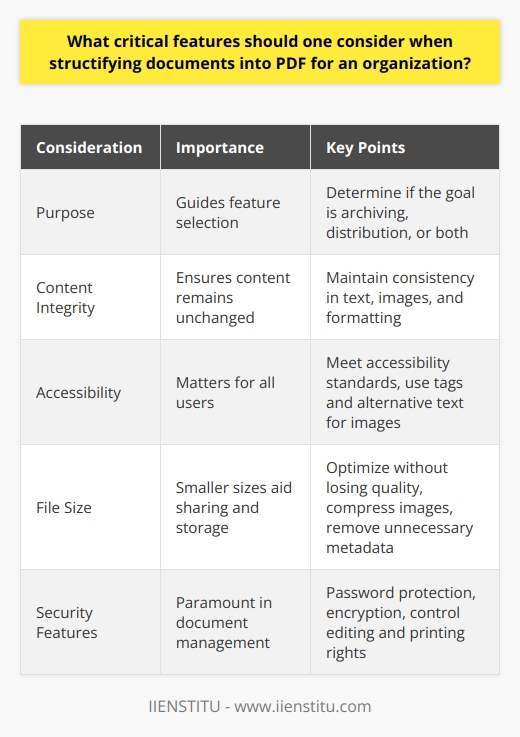
The organizational prowess of PDFs has become increasingly critical in a digital world where the presentation and sharing of documents are as important as their content. A structured document extends beyond mere text on a page; it involves an intentional arrangement of information which facilitates understanding and interaction.
This article delves into the myriad benefits that well-organized PDF documents present. Specifically, it underlines the pivotal role that such organization plays in maintaining the integrity and utility of documents. From enabling seamless mba class online enrollments to simplifying the dissemination of online courses materials, structured PDFs are reshaping the way we manage and consume information.
Understanding Structured Documents in PDF Format
Definition and Importance of Structured Documents
Structured documents are meticulously crafted with layers of information that enhance a reader's ability to navigate, understand, and engage with the content. They are a linchpin in the realm of document organization, ensuring that readers can easily pinpoint and comprehend the data presented.
In the context of PDF formatting, structuring involves a harmonious blend of textual content, multimedia elements, and interactive features that come together to form a coherent and easily navigable file.
Characteristics of a Well-structured PDF Document
A well-structured PDF transcends basic text to incorporate elements such as lists, tables, links, and embedded fonts, which uphold the document's original design and layout across diverse platforms.
Such documents harness the capabilities of PDF standards, enabling features like annotations, form-filling, and media inclusion, without sacrificing compatibility. The enduring appearance and functionality of these documents are testament to the format's robustness, further advocating for its pervasive use.
How PDFs Maintain Document Formatting and Layout Across Platforms
PDFs are renowned for their ability to maintain a consistent user experience, regardless of the hardware or software from which they're accessed. This cross-platform compatibility is a cornerstone of their design, ensuring that a PDF saved on one device will appear identical on another, preserving the document's structure and layout integrity. Such consistency is vital to both casual and professional engagements with documents and is one of the reasons why PDFs have become a universal standard.
The Advantages of an Organized PDF
Accessibility and Searchability
An organized PDF enhances navigation within the document through the use of bookmarks and hyperlinks, which facilitate quick access to different sections. Structured PDFs also cater to the needs of users with disabilities by incorporating tags that provide a semantic structure, making the content accessible to screen readers and assistive technologies. For those embarking on online courses, such features are indispensable for creating a learning environment that is inclusive and adaptable to individual needs.
Enhanced Security
Security is a paramount concern for document creators and users alike, and organized PDFs address this through a range of options. Restricting access, setting permissions, and using digital signatures add layers of security to prevent unauthorized alterations and confirm authenticity. Similarly, watermarks can be employed to indicate ownership or to delineate the status of a document. These measures contribute to the PDF's prominence in secure and official exchanges.
Consistent Collaboration and Sharing
In the context of collaboration, organized PDFs serve as a common ground upon which multiple parties can operate. The standardized format mitigates misinterpretation or data loss during transfers, providing an unaltered environment for team inputs. PDF features such as commenting and review tools turn the document into a dynamic workspace where ideas can be exchanged without compromising the document’s core content. It's these collaborative capacities that make structured PDFs invaluable in complex workflows and projects.
How to Achieve Effective PDF Document Organization
Tools and Techniques for Organizing PDFs
Effective PDF organization is achieved by utilizing a suite of tools designed to enhance a document's structure. Bookmarks, hyperlinks, and properly applied tags guide readers through sections with ease, while Optical Character Recognition (OCR) technology transforms scanned text into searchable and editable content. These tools are essential in constructing a document that is both user-friendly and suited for long-term digital storage and retrieval.
Software Solutions for Structuring PDFs
Achieving an organized document is greatly facilitated by using sophisticated PDF editing software. These applications offer more than basic editing capabilities; they provide an array of customizable features aimed at creating a coherent, structured document. Users can define and enforce styles, create forms, and manage annotations, all within an intuitive interface that streamlines the document organization process.
Best Practices in PDF Organization
Adhering to best practices in PDF organization ensures that documents are both aesthetic and efficient. Utilizing hierarchical structures, employing consistent styles, and crafting templates paves the way for standardized and comprehensible documents. Additionally, integrating visual aids — such as graphs, tables, and images — amplifies the clarity and impact of the information, steering a document towards its maximum potential for communication and function.
Organization PDF Benefits: Real-world Applications
The real-world efficacy of organized PDFs is evident across various industries, from legal practices to educational institutions. Case studies showcase how structured PDFs have streamlined archival systems, facilitated legal document analysis, and underpinned complex academic resources, such as those needed for an mba class online. Common documents that benefit from PDF organization include contracts, reports, instructional materials, and research papers.
Impact on Business Efficiency
In the business realm, the influence of structured PDFs on operational efficiency cannot be overstated. From reducing paper use to enhancing document discoverability, these organized documents enable companies to execute processes with greater speed and accuracy. Testimonials from professionals across sectors underscore the transformative effects that adopting an organized PDF strategy has on both time management and the bottom line.
Recapping the pivotal themes discussed, the importance of structured PDFs is clear: they are a cornerstone of modern document organization.
Their adoption streamlines processes, fortifies security measures, and fosters collaborative efforts, all of which are essential in today's interconnected, digital-centric world. Embracing organization PDF strategies not only enhances personal productivity but can also induce a paradigm shift in corporate document management practices.
As we consider the transformative impact structured documents can have, we invite readers to share their experiences and insights on organized PDFs. Your feedback is invaluable in shaping a collective understanding and in pushing the boundaries of document management excellence. For those looking to delve deeper into the art of PDF organization, we encourage you to seek out further reading and resources to master these skills and techniques.
Frequently Asked Questions
What are the benefits of structuring documents within an organization?
Benefits of Structuring Documents in Organizations
Enhancing Accessibility and Retrieval
Structured documents foster seamless accessibility. They enable swift retrieval of information. Clear organization aids employees. It reduces search times significantly. Ease of access aligns with productivity gains. Structured documentation supports different user roles. It allows for privilege-based access controls.
Ensuring Consistency and Uniformity
Document structure brings about uniformity. It enforces a standardized approach to information handling. Templates and guidelines ensure consistent document creation. This consistency aids in brand uniformity. It projects a professional image externally. Internally, it simplifies interpretation and reduces errors.
Facilitating Knowledge Sharing
Knowledge becomes more shareable with structure. Documents serve as knowledge repositories. A well-defined structure promotes collective wisdom. This encourages collaborative work environments. Silos break down. Cross-departmental collaboration flourishes. Organizational knowledge thus grows dynamically.
Streamlining Collaboration
Structuring enhances collaborative efforts. Multiple people can work on a document simultaneously. Changes remain clear and traceable. Version control is integral to this process. It prevents confusion and losses in productivity. Collaboration tools often rely on document structuring.
Improving Document Security
Document security improves with structure. Sensitive documents get proper categorization. Access restrictions become easier to implement. Auditing trails are clearer in structured systems. Thus, compliance with regulations becomes straightforward. Security protocols integrate seamlessly with structured setups.
Supporting Disaster Recovery
Structured documentation aids in disaster recovery. Well-organized documents allow for quick backups. It ensures critical information remains retrievable. Companies can rebound from data losses more easily. Business continuity plans rely heavily on such structures.
Facilitating Legal Compliance and Auditing
Legal compliance requires organized documentation. Audits become less cumbersome with structured documents. Auditors locate necessary information quickly. Companies demonstrate due diligence efficiently. Proper classification helps in aligning with legal requirements.
Enhancing Customer Service
Customer service benefits from document structure. Staff find information rapidly. They respond to customer inquiries effectively. Documentation becomes an asset in customer interactions. Satisfaction levels often reflect documentation quality.
Promoting Efficiency and Productivity
Efficiency is key to organizational success. Structured documents streamline various processes. Productivity enhances as a result. Employees navigate systems with ease. Time management becomes more effective. Organizational goals align with efficient documentation strategies.
Fostering Continuous Improvement
Finally, structure supports continuous improvement. Companies analyze documents for operational insights. They adjust strategies based on solid data. Document analysis leads to process optimization. Continuous feedback loops encourage iterative improvements.
In conclusion, structured documentation offers manifold benefits. From enhancing accessibility to fostering continuous improvement, it underpins organizational efficiency. Companies that leverage structured document systems gain competitive advantages. They navigate the complexities of information management with agility. They stand better positioned to meet their strategic objectives.

How does PDF contribute to the organization and structure of documents?
Understanding PDF's Role in Document Structure
Portable Document Format (PDF) stands as a cornerstone in document management. It provides a universal framework. This framework ensures consistent presentation. Documents maintain their structure across different platforms. PDFs are crucial in several capacities.
Uniformity and Consistency
At its core, PDF maintains uniformity. This file format locks down layout and formatting. Users everywhere see content the same way. Text, images, and other media retain their positions. Fonts and styles remain unchanged. This uniformity is vital for formal documents. Examples include contracts, legal documents, and research papers.
Content Organization
PDFs support detailed content organization. They can contain bookmarks and hyperlinks. These tools enhance navigation through complex documents. Thus, they make it easier to find sections or references. Consider large reports or instructional materials. Here, well-organized navigation aids are essential.
Integrated Multimedia
PDFs hold more than just text. They can integrate multimedia elements. Images, videos, and hyperlinks combine with text. They form a cohesive, structured document. This integration aids in creating engaging presentations. Information delivery becomes more effective.
Security Features
PDFs offer robust security features. Access control is one such feature. Creators can restrict opening, printing, or editing documents. Digital signatures provide authenticity. They verify a document's origin and integrity. These options help maintain document structure. They protect it from unauthorized alterations.
Accessibility
The structured nature of PDFs supports accessibility. Documents can include tags for screen readers. This helps visually impaired users. The structure allows easy conversion into various formats. Examples include text-to-speech and Braille.
Portability is a fundamental aspect. PDFs work across multiple operating systems. No special software is necessary beyond a reader.
Compression abilities benefit storage and sharing. PDFs compress large documents. This preserves quality while reducing the file size.
Interactive elements enrich user engagement. Forms in PDFs collect data. They provide interactive experiences for users.
PDFs play a pivotal role in document management. Their ability to preserve document structure stands out. This format serves diverse needs. It is well-suited for archiving purposes. PDFs are the gold standard for finalizing documents. They maintain organization across different systems and devices. The structure stays intact, from creation to dissemination.

What critical features should one consider when structifying documents into PDF for an organization?
Considerations for PDF Document Structurization
Understand the Purpose
Know why you convert documents into PDFs. Recognize the aim. It guides feature selection. Is the goal archive, distribution, or both?
Maintain Content Integrity
PDF format ensures content stays unchanged. It is vital. Text, images, and formatting must remain consistent. Document integrity is crucial for organizational records.
Ensure Accessibility
Accessibility matters for all users. PDFs should meet accessibility standards. Use tags and alternative text for images. Ensure screen readers work well.
Optimize File Size
Smaller file sizes aid sharing and storage. Optimize PDFs without losing quality. Compress images. Remove unnecessary metadata.
Implement Security Features
Security is paramount in document management. PDFs allow password protection. Use encryption. Control editing and printing rights. Protect sensitive information.
Support for Metadata
Metadata organizes and identifies documents. Include relevant metadata. It aids in search and retrieval. Consider titles, authors, and keywords.
Facilitate Collaboration
Enable comments and annotations. They support teamwork. Consider review and feedback processes. Make sure they are seamless.
Compatibility Across Platforms
PDFs should open on all devices. Ensure cross-platform compatibility. Users should access documents on any hardware or operating system.
Searchability within Text
Searchable text supports work efficiency. Ensure PDFs have this feature. OCR (Optical Character Recognition) may be necessary. Convert scanned text to searchable text.
Retain the Logical Structure
Maintain headings, lists, and tables. They organize content. Preserve the original document's logical flow.
Embed Fonts
Embedding fonts preserves the intended look. Ensure the PDF displays correctly on all devices. It avoids substitution issues.
Include Hyperlinks and Interactive Elements
Hyperlinks connect to resources. Make them clickable in the PDF. Include interactive elements if necessary. They enhance the user experience.
Provide Update and Version Control
Document versions matter in organizations. Make sure to track changes. Use clear versioning within the PDF properties.
Automation Capability
Consider automation for large organizations. Automate PDF conversion where possible. Save time and reduce human error.
Ensure Print-Ready Format
Sometimes documents must be printed. Ensure PDFs are print-ready. Check dimensions and print settings.
Archive Compatibility
Use PDF/A for archival purposes. It is an ISO-standardized version. It ensures long-term archiving.
Selecting the right features for PDF documents is critical. Tailor choices to organizational needs. Efficiency, security, and accessibility guide these choices. Implement them effectively for smooth document management.



